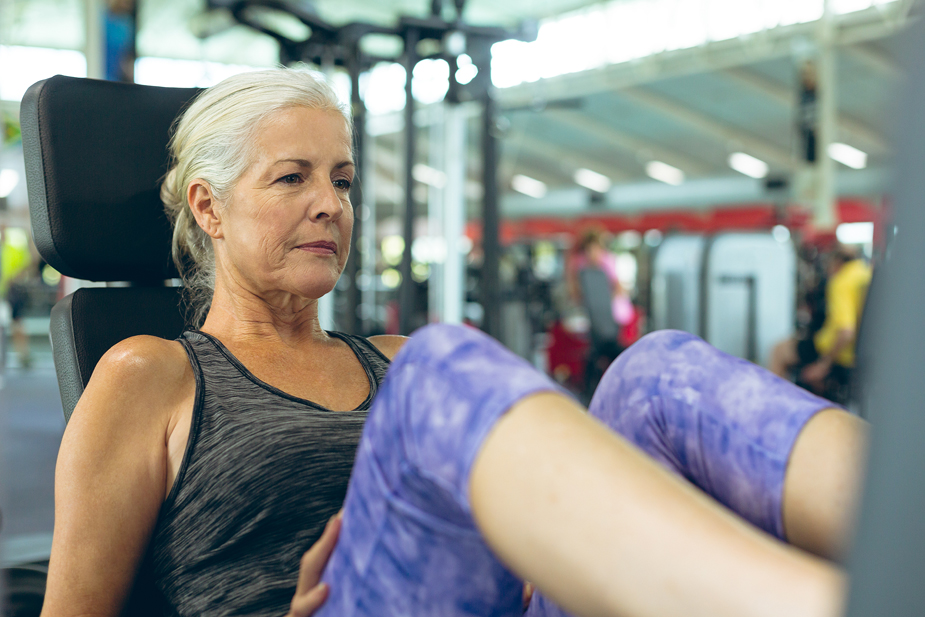
|
 |
Health Club Management Handbook - Predictions 2021

Industry insights

|
|
| Predictions 2021
|

HCM invited industry experts from around the world to warm up their crystal balls and share thoughts on what the next year will hold
|


Specialist equipment and training will continue to fuel demand for bricks and mortar clubs, says Alicia Whistlecroft shutterstock/FotoAndalucia
|
|
Alicia Whistlecroft
Assistant director,
Deloitte corporate advisory
 PHOTO: Deloitte
I anticipate people showing a renewed appreciation for their health and wellbeing and looking to increase the amount they exercise.
The industry has seen some membership attrition due to the anticipated economic challenges for consumers. This was probably less severe in the budget segment when compared to the mid-market and premium segments, as a consequence of the proportion of discretionary income the membership accounts for.
Many operators believe a large part of their initial attrition was from sleeping members. Since the start of the pandemic, businesses have been forced to explore ways of engaging more with customers which goes to the heart of the biggest challenge in the industry: minimising churn.
The quick pivot to adapt offerings, by developing digital content sharing platforms enabled operators to keep members engaged, which is expected to have a positive impact on customer retention figures going forwards.
As the lockdowns reoccurred, several operators were able to introduce charges for their various online offerings, such as pay-as-you-go or new online subscriptions.
Nonetheless, the pandemic has put a huge financial strain on many UK operators, due to the large periods of 2020 where revenues were essentially zero. The initial hit on the industry signalled yet another downturn in the already squeezed mid-market and less focussed businesses, which resulted in a few distressed merger and acquisition processes last summer, including Xercise4less and DW Sports, largely from the rump of the mid-market sector.
Strong balance sheets
Operators who have been able to weather the storm the best are those who had strong balance sheets going into the pandemic and have been able to support their liquidity by negotiating rent holidays with landlords, business rates holidays and tax deferrals and using furlough.
Where operators are still liable for these payments, more distressed assets are likely to come to market as these amounts fall due. So it’s likely we’ll see more consolidation within the industry, as the disruption continues to exacerbate the prevailing issues affecting the mid-priced fitness segment.
Several operators have slowed or halted their rollout plans, while they focus on existing portfolios and seeing themselves through to the other side of the pandemic. So, while it’s clear there will still be some opportune new site openings, some operators will delay significant roll-out plans until there’s a clear roadmap to recovery.
The pandemic has opened people’s eyes to the different approaches to training outside the gym. We’ve seen a huge increase in outdoor activity, such as running and cycling, as well as increased use of online digital content. Many operators have realised these changes will have a lasting impact and are now diversifying to a hybrid offering, which will help to future-proof businesses and be popular with members.
The way ahead
There’s still a firm view that even with the increased level of digitisation, there’ll always be demand for bricks and mortar fitness operators, because there are some types of training which cannot be achieved online or at home to the same effect.
There is also a consensus that the action of physically going to a gym or studio helps people stay committed and motivated – people seem to find excuses at home.
In other sectors which have recovered strongly, we have seen a return to pre-COVID pricing and so we expect a strong bounce back in health and fitness.
Budget operators are likely to be among the first health and fitness businesses to recover and may benefit from customers trading down the pricing spectrum.
If operators take forward all the lessons learned since the start of the pandemic, as well as riding the anticipated interest in health and fitness as final restrictions are lifted, the sector should become an ever more vibrant, diverse and exciting segment for investment and development in the years to come.
There will always be demand for bricks and mortar fitness operators, because there are some types of training which just cannot be achieved online or at home to the same effect.

Specialist equipment and training will continue to fuel demand for bricks and mortar clubs, says Whistlecroft / shutterstock/FotoAndalucia
Jay Ablondi
Executive vice president of global products
IHRSA
 PHOTO: IHRSA
Together, the health and fitness industry will emerge from this global pandemic with a renewed sense of purpose. As we have already witnessed in Asia, and other regions where clubs have reopened, members have flocked back to clubs to enjoy the camaraderie, support, sense of community, and experience that only they provide.
In some key health club markets, such as Tier 1 cities in China, participation is already surpassing the record levels reached in 2019. The demand for clubs is clearly there, as the pandemic has raised awareness of how important it is to take care of your health and make time for exercise and physical activity.
A number of lessons have been learned during this time which will have an impact on the industry going forward. We learned we’re more effective together than apart. Although the pandemic had the power to divide, we created a united industry, which has given us a louder voice, and protected us from worse outcomes.
The pandemic is highlighting the importance of streamlining operations and managing costs. Many operators have reported making modifications which allow them to operate at a lower cost structure. Furthermore, while clubs were closed there was wide scale investment in air-purification systems and safety and cleaning measures, which will benefit members going forward.
Technology is here to stay and is going to be crucial to the long-term success of our industry. Many clubs did a phenomenal job of quickly transitioning to online-only classes and beefed up their presence on social media, Zoom and other platforms to serve their communities beyond the four walls of the facility.
Clubs which have done the best during this time were fully engaged with their members and communities and communicated their business’ values and core beliefs over and over. They made sure to let their members know by their actions – not just words – that the health and wellbeing of their community and employees was the most important factor driving their business decisions.
The pandemic has highlighted that we still have work to do to reverse decades of misperceptions about our industry and a lack of engagement with the healthcare and government communities. However, we are getting the message out that health clubs are essential and people are learning how important exercise is when it comes to improving overall health and strengthening one’s immunity.
Clubs which have done the best have been fully engaged with their members and communities and communicated their values and core beliefs

Asia was the first market to re-open and members flocked back to clubs / shutterstock/CrispyPork
Simon Flint
CEO,
Evolution Wellness
 Photo by Justin Tiew
Since the start of the pandemic, the industry has done well to come together and collaborate for the good of all. We represented the facts intelligently and passionately in support of what we provide and presented a compelling case that we could operate safely under challenging circumstances.
Across the world, the industry lobbied and made new relationships with government officials, to channel our information in support of better outcomes. I’m convinced these efforts saved jobs and protected livelihoods across the sector.
Going forward, we need to build on this work to earn due respect for the industry, with tirelessly lobbying backed up by data to prove all the key points we want to make.
We still have a bumpy ride ahead of us, with more business closures, some consolidation and some changed consumer patterns which will take longer to unwind.
Some customers will be lost forever, as they settle in to different habits and patterns. But equally, new customers will emerge to change the customer landscape. It’s likely the age of gym members will trend downwards in some markets, especially where digital engagement is at the front-end of the customer experience.
Fitness is booming and this will continue. As to how it is consumed, that’s another story. I expect affluent, less economically disrupted markets will experience a surge, while some markets will take longer to limp back to recovery. Most of the action will be at the top and bottom of the price spectrum, with less happening in the middle.
Research during lockdown showed a significant slice of our membership base was super keen to get back to the gym. Forty two per cent said: “I don’t care what my first workout is, I just want to get back!” Others are more cautious and say they’ll wait until they’re fully vaccinated.
Many who have formed new habits – outdoors, online, gym at home – will find their own new normal. This poses both a challenge and an opportunity for operators to complement these choices, so as not to force consumers into a binary decision.
Some markets will swiftly bounce back almost to the old normal. Humans have an innate need for social contact and to feel good and we should continue to see the fruits of recently pent-up demand.
Some customers will be lost forever, as they settle in to different habits and patterns. But equally, new customers will emerge to change the customer landscape.

Operators need to be sensitive to consumer demand and not force customers to make binary decisions / shutterstock/Gorodenkoff
Dave Stalker
President,
EuropeActive
 Photo by John Hooper
Despite 2020 being the most challenging year in our sector’s history, some great initiatives were put together which resonated both at a European and at international level.
The move to reposition the sector towards public health is both exciting and daunting, but it’s crucial we’re perceived as an essential solution to this crisis.
Fitness representatives and experts should promote our responsibility to be providers of physical activity as a proven way of supporting social, physical and mental health and wellbeing.
Without exception, the people who make up our industry have risen to the task and I am truly proud of how they’ve embraced the challenges, united against a common enemy and steadfastly driven the industry forward. Operators’ reaction in terms of hygiene and safety measures to guarantee fitness facilities are safe places to exercise has been exemplary.
It’s of paramount importance that our sector continues to work together as a solid industry with the ambition of coming back stronger and to this end, EuropeActive has been developing Active Alliances with our national and trade associations, partners such as an MoU with ukactive, as well as building strong strategic partnerships with NGOs and commercial actors which support the vision of our Sectoral Manifesto – for example an extended partnership with FIBO – so we can ensure the most effective recovery of the fitness and physical activity sector with leaders and experts.
A large part of the industry has been suffering significantly during this crisis, but the sector has proven to be flexible enough to adapt to the challenging circumstances through self-critical and creative thinking.
We’ll need to keep reinventing ourselves through 2021 and into 2022 to successfully recover from the impact of COVID-19 and to redefine what we offer, in order to create an attractive business environment for our workforce.
Club operators have been able to adapt their business models and survive in the toughest situation they’ve faced so far. Being fully committed to informing and assisting members, address vulnerabilities and repositioning themselves to make the most of the vast opportunities which will arise as we come out of the pandemic, will be the right pathway for operators to follow.
The EuropeActive Sectoral Manifesto Horizon 2025 lays out four key priorities: working with the health sector, embracing digital, growing community and raising standards. All operators who embrace these in their mission and vision will be supporting the industry and will also undoubtedly reap the rewards.
It’s of paramount importance that our sector continues to work together as a solid industry with the ambition of coming back stronger

The health and fitness sector has been exemplary in terms of hygiene and safety measures / shutterstock/Picsfive
Mike Hill
Co-owner,
Leisure-net
 Photo by Jo Monkhouse
Since the start of the pandemic, operators have had to think outside the box and this looks set to continue for the foreseeable future. However, at least now it’s possible to start making long-term, sustainable plans, with the confidence most members will be keen to return.
Some people have started to make other exercise habits, but still our research reveals a strong appetite for returning to the gym and engaging with instructors. Sixty six per cent of the people we questioned rated the friendliness of staff as very important and 63 per cent said the support and guidance of the team is very important.
Making the gym environment safe was important to people, but the sector in the UK got this right following the first two lockdowns, with 69 per cent of gym members saying they were confident about the protocols put in place. As the vaccination programme progresses, hopefully those who felt nervous, will regain confidence.
Going forward, there are three key areas for operators to focus on. Firstly, is creating confidence in customers around the systems, procedures and protocols put in place for dealing with COVID-19 and communicating to members gyms are proven to be safe, regulated environments.
Operators will also need to offer a more targeted service, with different sessions for segments of the market who want different things. The sector has shown an impressive pivot to digital and going forward will need to dovetail these services with their in-club offering in terms of operations and pricing.
For members who’ve found alternative ways to exercise, operators need to engage and prove how clubs can complement their new activities. For example, someone who’s started cycling could power up hills better if they complement it with strength training.
The sector has shown an impressive pivot to digital and going forward will need to dovetail these services with the in-club offering

Those who take part in group exercise stayed the most active during the lockdowns / shutterstock/Lucky Business
Karsten Hollasch
Global private equity leader,
Deloitte
 PHOTO: DELOITTE
The industry has learned valuable lessons and made adaptations which will help going forward. We have learned how to lobby effectively, as well as co-operate as a sector. In Germany, in addition to the fitness association, we have seen large rival operators join forces to run marketing campaigns to promote the industry and get across the message that clubs are safe environments. In 2021-22, the industry will need to do even more: speaking with one voice creates much more volume.
Digitalisation has become a must-have, not a nice-to-have, not just for virtual workouts, but in order to control capacity and track who’s coming to the club. Arguably digitalisation should have happened years ago, but the pandemic has been a catalyst for huge leaps forward.
Annual or two-year contracts are the norm in Europe, so last year many operators were able to retain their members through a mixture of good communication and incentives.
However, at the start of 2021, European operators were hit by a double whammy of not being able to recruit new members in the most lucrative months of the year, and losing some of the members who joined in early 2020. While UK operators suffered high attrition last year, European operators have more of this to face going forward.
People will come back to clubs, but I think it will take time before the industry recovers to 2019 levels. Lockdown easing coinciding with good weather in Europe means many people will have carried on exercising outdoors, which will delay the recovery.
Digitalisation has become a must-have, not a nice-to-have, not just for running virtual workouts, but in order to control capacity and track who’s coming to the club

Lockdown easing coinciding with good weather in Europe could delay the recovery due to people exercising outdoors, says Hollasch / shutterstock/NDAB Creativity
Mark Sesnan
Chief executive
GLL
 Photo by Andrew Baker
No one in the UK local authority leisure contracting space would want to go back to where we were pre-COVID-19. Public leisure centres had been dragged down a grubby route of ‘least cost’ by years of misplaced concepts of tendering and quasi commercialisation. We were thrown into a toxic environment, where often the only way of winning contracts was to go low price, despite many procurement exercises trying to dress this up with quality thresholds.
Not all, but most, local authorities have come good during the pandemic in so far as they have recognised the need to support and preserve their leisure assets for their community and have adopted an open book and partnership approach to the crisis.
This has enabled a real understanding of the issues in our industry to emerge for the first time, leading to a much more intelligent approach to how clients and contractors work in partnership as we move forward.
Inevitably there will be some fundamental changes to the public leisure offering. Older buildings which are uneconomic to run will have their demise accelerated, especially as carbon neutral ambitions are put into the mix. The switch to apps has enabled customer journeys to become the norm, with cash becoming largely extinct.
Customer experience will become even more important for all of us now we have raised expectations on cleanliness, bookings reliability and ease of accessibility. Prices may have to rise to cover higher costs.
The role of leisure centres in promoting and supporting better health alongside the NHS in our communities is now obvious: we are an essential service. I am optimistic our industry will emerge stronger and begin to be properly recognised for the vital role we play in promoting meaningful and enjoyable activity for all ages delivering better health outcomes for all and a better society for us all to enjoy.
The role of leisure centres in promoting and supporting better health alongside the NHS in our communities is now obvious: we are an essential service

Apps will become the norm as more clubs go cashless / shutterstock/Bojan Milinkov
Martyn Allison
Social change agent and influencer
 PHOTO: Martyn Allison
The public sport and leisure sector is inevitably going to be reshaped by the pandemic just like every other part of the economy. My prediction is that it could be reduced by as much as 20 to 30 per cent depending how councils manage their own financial challenges.
My experience of the sector shows it handles change differently. One third will always relish the opportunity to change, reinvent itself, respond positively to the new landscape and build back better and fairer. A third will adapt more slowly and incrementally and will need to be encouraged and supported to adapt. But up to a third are likely to resist change and hang on to the hope that everything will get back to normal soon. It’s this third that is most likely to disappear and it will not be part of the future.
The third which is likely to disappear is just as likely to be a private contractor, or a trust or an in-house operator, because it is the quality of management and leadership in both the operator and the client council which will dictate the outcome. Unless councils see the value of their facilities rather than just the price, and operators can respond to the changing landscape I fear we will see significant closures.
The key question is which ones will be retained and which will disappear? Logic would suggest the big, new modern centres will survive and the older outdated ones will go. But this will depend on what councils wish to achieve with their facilities and how best their desired outcomes can be delivered. Some councils for example may decide to sell or lease the glossy new ones to private providers and use the capital receipts or rental income to retain and improve the smaller community venues which are better at serving the more deprived communities.
I think the same rationalisation process will also generate more multi-service community hubs, focused more on health and wellbeing than sport and fitness. This could have some real challenges for traditional sport clubs, particularly swimming clubs, who could find themselves with less water space or having to take on the management of their own facilities. The rationalisation process could also see a rebalancing from indoor to more outdoor facilities and a greater reliance on digital access is certain.
Another response to recovery will be for councils to bring facilities back in house, either through direct management or by forming a local authority trading company. We have already seen a few councils take such decisions for a number of reasons: as a response to a contract irrevocably breaking down with a management contractor or trust; the desire to simply take back more control, or as a temporary solution until the market settles back down and they can go back out to tender.
With health inequalities worsening before the pandemic and now made even worse by the pandemic many local authorities will need to think carefully about how they respond and better serve the needs of those in their community who were already most likely to be excluded and have fared the worst during Covid.
As I have shown recently in my writing on Marmots proportional universalism, the sector as a whole tends to be weaker at meeting the needs of those least well off who have the biggest health needs, irrespective of the management model. While we may claim to have improved some people’s health we have actually been making health inequalities worse. White, able males tend to be well served by all the management models, but families living with multiple deprivation are equally poorly served by them except for a socially minded trust and some in house services.
The challenge for councils and operators is how do they address these fundamental inequalities in health in contracts which have previously been less attractive for those in need, when councils face a huge financial crisis themselves. It is this situation which will need to be addressed in the recovery and it will not be easy.
The challenge for councils and operators is how do they address these fundamental inequalities in health in contracts which have previously been less attractive for those in need, when councils face a huge financial crisis themselves

Existing health inequalites have been made worse by Covid: another challenge for the public sector / shutterstock/Halfpoint

Sadly, it is inevitable some local authority sites will close / shutterstock/wavebreakmedia
|
|
 |
| Originally published in HCM handbook 2021 edition
|
|
 |
|
